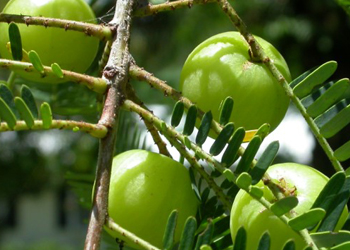
Phyllanthus emblica |
 |
Draelos, Z. D., M. Yatskayer, P. Bhushan, S. Pillai and C. Oresajo. 2010. Evaluation of a kojic acid, emblica extract, and glycolic acid formulation compared with hydroquinone 4% for skin lightening. Cutis. 86, 3: 153-158. Abstract: Hydroquinone has been the standard prescription agent for skin lightening; however, its use recently has become controversial. Hydroquinone is banned in Europe and parts of Asia because of potential long-term consequences, including carcinogenesis when orally consumed. These concerns have stimulated research to develop alternative skin lightening agents with efficacy comparable to hydroquinone but with a better safety profile. This double-blind study examined the skin lightening ability of a topical formulation containing kojic acid, emblica extract, and glycolic acid compared with prescription generic hydroquinone cream 4%. Eighty multiethnic participants with mild to moderate facial dyschromia were randomly assigned to use the study product or hydroquinone 4% twice daily for 12 weeks to evaluate product efficacy, tolerability, and safety using investigator assessment, participant assessment, and dermospectrophotometry. Study results demonstrated efficacy parity between the study product and hydroquinone 4%. Thus this novel skin lightening preparation is an alternative to hydroquinone 4% for participants with mild to moderate facial dyschromia. ...................................................................... Nosál’ová,G., J. Mokrý, and K. M. Tareq Hassan. 2003. Antitussive activity of the fruit extract of Emblica officinalis Gaertn. (Euphorbiaceae). Phytomedicine 10: 583–589. Summary; The antitussive activity of Emblica officinalis Gaertn. (E. officinalis, Fam. Euphorbiaceae) was tested in conscious cats by mechanical stimulation of the laryngopharyngeal and tracheobronchial mucous areas of airways. The results showed that at a dose of 50 mg/kg body wt. perorally, the cough suppressive effect of E. officinalis is not unambiguous. Ahigher dose (200 mg/kg body wt.) of this substance perorally was more effective, especially in decreasing the number of cough efforts (NE), frequency of cough (NE/min–1) and the intensity of cough attacks in inspirium (IA+) and expirium (IA–) was more pronounced. These results showed that the cough suppressive activity of E. officinalis is dose-dependent. We could also demonstrate that the antitussive activity ofE. officinalis is less effective than shown by the classical narcotic antitussive drug codeine, but more effective than the non-narcotic antitussive agent dropropizine. It is supposed that the antitussive activity of the dry extract of Emblica officinalis is due not only to antiphlogistic, antispasmolytic and antioxidant efficacy effects, but also to its effect on mucus secretion in the airways. ......................................................................................................... K.H. Khan. 2009. Roles of Emblica officinalis in Medicine - A Review. Bot. Res. Intl. 2, 4: 218-228. Abstract: Emblica officinalis (Amla) are widely used in the Indian system of medicine and believed to increase defense against diseases. This article discuses and summarizes important medicinal values of Emblica officinalis (EO). In this communication, we reviewed the applications of EO in cancer, diabetis, liver treatment, heart disease, ulcer, anemia and various other diseases. The use of EO as antioxidant, immunomodulatory, antipyretic, analgesic, cytoprotective, antitussive and gastroprotective are also reviewed. Its applications for memory enhancing, ophthalmic disorders, lowering cholesterol level are focused. The effects of EO in neutralizing snake venom and as an antimicrobial are also included. This paper also review the retrospective studies on the Amla at molecular level. ................................................................................................. Nantanat Mahattanapokai. 2003. Preparation and Evaluation of Emblica officinalis Extract Cream. M. Sc. Thesis, Mahidol University, Bangkok. .......................................................................................................................... Antony, B., M. Benny and T. N. B. Kaimal. 2008. A PILOT CLINICAL STUDY TO EVALUATE THE EFFECT OF EMBLICA OFFICINALIS EXTRACT (AMLAMAXTM) ON MARKERS OF SYSTEMIC INFLAMMATION AND DYSLIPIDEMIA. Indian Journal of Clinical Biochemistry 23, 4: 378-381. ABSTRACT; Emblica officinalis Gaertn., commonly known as the Indian gooseberry or “Amla”, has been used as health food for centuries in India and other Asian countries. The biological effects of amla have been attributed to the antioxidant properties of the low-molecular weight hydrolysable tannins present in the fruit. AmlamaxTM is a purified, standardized, dried extract of amla containing about 35% galloellagi tannins along with other hydrolysable tannins. Our earlier studies on rabbits showed significant reduction in total cholesterol and triglycerides as well as increase in HDL. The present study extends these results to human volunteers. Two doses of the extract were evaluated - 500 mg and 1000 mg per day for 6 months. Blood samples were collected at the 3rd and 6th months showed reduction in total and LDL cholesterols and enhancement of beneficial HDL cholesterol. In addition, blood CRP levels, a marker for inflammation, were also significantly reduced. Since dyslipidemia and inflammation are the two major components of cardiovascular diseases, the present results must be considered encouraging and indicate the potential of AmlamaxTM in the management of heart diseases. |
| กลับหน้าหลักสมุนไพร |
